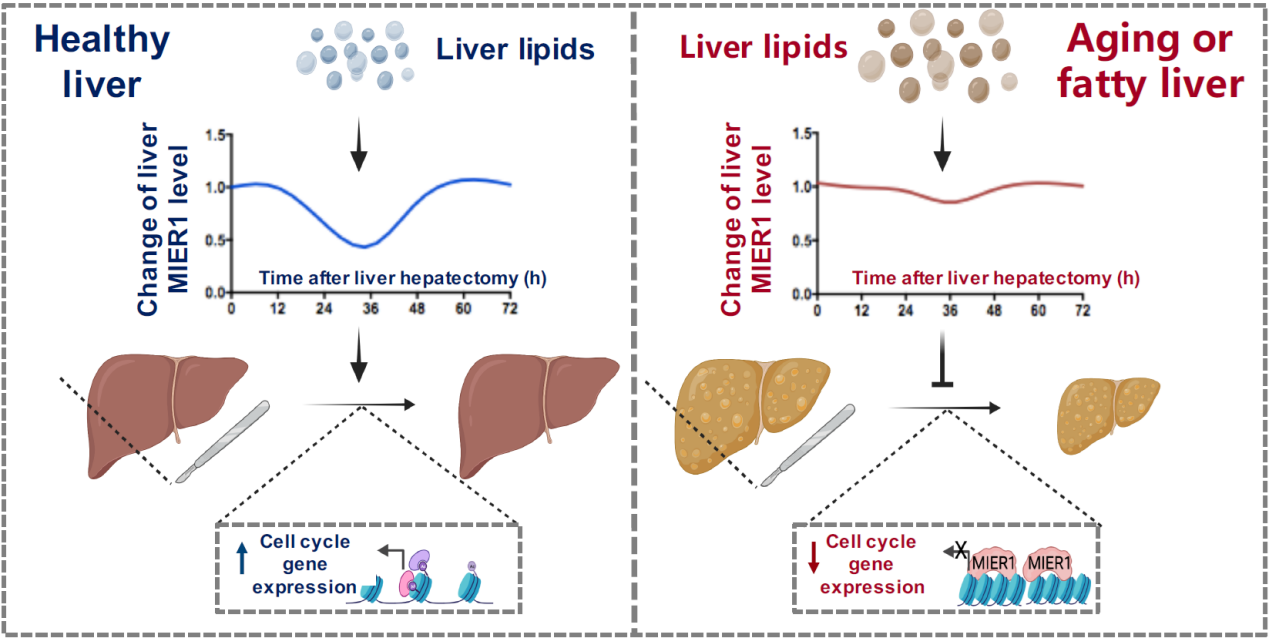Scientists Identify Key "Bridge" Factor Mediates Transition of Liver Lipid Signals to Regeneration Capacity
A recent study by Dr. DING Qiurong’s group from the Shanghai Institute of Nutrition and Health (SINH), Chinese Academy of Sciences (CAS) and collaborators discovered that the transient accumulation of liver lipids during liver regeneration serves as a regeneration and repair signal that promotes liver cell proliferation.
Healthy liver tissue has a great regenerative capacity after injury. However, the regenerative capacity is significantly weakened in liver with lipid metabolism disorders, such as fatty or aging liver. It has been previously well recognized that hepatic lipid homeostasis is critical for maintaining the liver regenerative capacity. For example, there exists an obvious acute lipid accumulation at the early phase of liver regeneration, and inhibition of this can seriously affect regeneration. However, how lipid homeostasis regulates regeneration and why the regenerative potential of livers with lipid metabolism disorders decreases are so far not clear.
In order to identify potential key regulators during liver regeneration, researchers constructed an in vivo CRISPR screening platform, and identified mesoderm induction early response 1 (MIER1) as a key regeneration regulator.
Through partial hepatectomy, researchers found that MIER1 plays an epigenetic "brake" role during liver regeneration. After hepatectomy, acute liver lipid accumulation induces a transient stress response in hepatocytes, resulting in an acute inhibition of ribosomal translation, thereby affecting MIER1 translation and causing dynamic downregulation of MIER1. MIER1 downregulation further promotes chromatin opening, cell cycle gene expression and liver regeneration.
Interestingly, this physiological regulatory process is significantly impaired in aging and high-fat diet-induced fatty livers, resulting in a consistently high expression of MIER1, thereby continuously suppressing cell cycle gene expression.
This study revealed an interesting underlying mechanism of how lipid homeostasis regulates liver regeneration, and identified the epigenetic factor MIER1 as a key "bridge" factor that mediates the transition of lipid signals to repair and regeneration capacity.
This work, entitled “Acute liver steatosis translationally controls the epigenetic regulator MIER1 to promote liver regeneration in a study with male mice”, was published in Nature Communications on March 18, 2023. This study was supported by grants from the Strategic Priority Research Program of the CAS and the National Natural Science Foundation of China, and also supported by the Center for Public Technical Service of SINH.

The function of acute liver steatosis in promoting liver regeneration via MIER1. (Image by Dr. DING’s group)
Media Contact:
WANG Jin
Shanghai Institute of Nutrition and Health,
Chinese Academy of Sciences
Email: wangjin01@sinh.ac.cn
Web: http://english.sinh.cas.cn/
